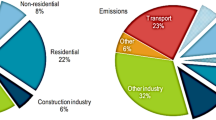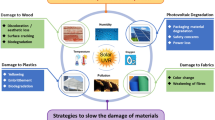Abstract
Interior fitting was performed stepwise in two model rooms built from Oriented Strand Board (OSB) and Cross Laminated Timber (X-lam), respectively. The walls and ceiling of the OSB model room were covered with gypsum plasterboard, parquet flooring was laid and the room was finally equipped with office furniture and textiles. In the X-lam model room an acoustical ceiling and parquet were installed. The walls were painted with wood stain and the room was adapted as bed room and equipped with textiles. After each fitting step volatile organic compounds (VOC) samples were taken and analyzed. In the OSB model room, the total volatile organic compound (TVOC) concentration decreased throughout the whole fitting process from 119 µg m−3 prior to the interior fitting to a final value of 26 µg m−3. In the X-lam model room, a change of the VOC profile and/or concentration could be observed after each fitting step. The highest TVOC concentration (225 µg m−3) was reached seven days after the installation of the acoustical ceiling. Terpenes, aldehydes and acetic acid were the most abundant substances identified. It was shown for both model rooms that some of the applied building materials acted as diffusion barriers or as emission sinks.


Similar content being viewed by others
References
AgBB (2015) Health-related evaluation of emissions of volatile organic compounds (VVOC, VOC and SVOC) from building products. Committee for health-related evaluation of building products. https://www.umweltbundesamt.de/sites/default/files/medien/355/dokumente/agbb-bewertungsschema_2015.pdf. Accessed 13.04.2015
Derbez M, Berthineau B, Cochet V, Lethrosne M, Pignon C, Riberon J, Kirchner S (2014) Indoor air quality and comfort in seven newly built, energy-efficient houses in France. Build Environ 72:173–187
DIN (2004) Indoor air. Part 6: determination of volatile organic compounds in indoor and test chamber air by active sampling on Tenax TA® sorbent, thermal desorption and gas chromatography using MS/FID.Berlin. Deutsches Institut für Normung e.V.
DIN (2008) Indoor air. Part 9: determination of emission of volatile organic compounds from building products and furnishing-Emission test chamber method. Deutsches Institut für Normung e.V, Berlin
Edwards RD, Jurvelin J, Saarela K, Jantunen M (2001) VOC concentrations measured in personal samples and residential indoor, outdoor and workplace microenvironments in EXPOLIS-Helsinki, Finland. Atmos Environ 35:4531–4543
Englund F, Nussbaum RM (2000) Monoterpenes in Scots pine and Norway spruce and their emission during kiln drying. Holzforschung 54:449–456
Geiss O, Giannopoulos G, Tirendi S, Barrero-Moreno J, Larsen BR, Kotzias D (2011) The AIRMEX study-VOC measurements in public buildings and schools/kindergartens in eleven European cities: statistical analysis of the data. Atmos Environ 45:3676–3684
Guo H (2011) Source apportionment of volatile organic compounds in Hong Kong homes. Build Environ 46:2280–2286
Guo H, Murray F, Lee S-C (2002) Emissions of total volatile organic compounds from pressed wood products in an environmental chamber. Build Environ 37:1117–1126
Hodgson AT, Rudd AF, Beal D, Chandra S (2000) Volatile organic compound concentrations and emission rates in new manufactured and site-built houses. Indoor Air 10:178–192
Höllbacher E, Rieder-Gradinger C, Stratev D, Srebotnik E (2015) A large-scale test set-up for measuring VOC emissions from wood products under laboratory conditions in simulated real rooms. Holzforschung 69:457–462
Järnström H, Saarela K, Kalliokoski P, Pasanen A-L (2006) Reference values for indoor air pollutant concentrations in new, residential buildings in Finland. Atmos Environ 40:7178–71791
Järnström H, Saarela K, Kalliokoski P, Pasanen A-L (2007) Reference values for structure emissions measured on site in new residential buildings in Finland. Atmos Environ 41:2290–2302
Jensen LK, Larsen A, Molhave L, Hansen MK, Knudsen B (2001) Health evaluation of volatile organic compound (VOC) emissions from wood and wood-based materials. Arch Environ Health 56:419–432
Jones AP (1999) Indoor air quality and health. Atmos Environ 33:4535–4564
Jorgensen RB, Bjorseth O (1999) Sorption behaviour of volatile organic compounds on material surfaces - The influence of combinations of compounds and materials compared to sorption of single compounds on single materials. Environ Int 25:17–27
Jorgensen RB, Bjorseth O, Malvik B (1999) Chamber testing of adsorption of volatile organic compounds (VOCs) on material surfaces. Indoor Air 9:2–9
Kim S (2010) Control of formaldehyde and TVOC emission from wood-based flooring composites at various manufacturing processes by surface finishing. J Hard Mater 176:14–19
Kostiainen R (1995) Volatile organic compounds in the indoor air of normal and sick houses. Atmos Environ 29:693–702
Liang WH, Wang C, Yang CQ, Yang XD (2014) Volatile organic compounds in different interior construction stages of an apartment. Build Environ 81:380–387
Makowski M, Ohlmeyer M, Meier D (2005) Long-term development of VOC emissions from OSB after hot-pressing. Holzforschung 59:519–523
Natureplus EV (2008) Certification criteria. timber and wood products. Product Group Guideline 0200, Available: http://www.natureplus.org/fileadmin/user_upload/pdf/cert-criterias/GL0200.pdf. Accessed 13.04.2015
Niedermayer S, Fürhapper C, Nagl S, Polleres S, Schober KP (2013) VOC sorption and diffusion behavior of building materials. Eur J Wood Wood Prod 71:563–571
Nyrud AQ, Bringslimark T, Englund F (2012) Wood use in a hospital environment: VOC emissions and air quality. Eur J Wood Wood Prod 70:541–543
Paczkowski S, Kraft R, Kharazipour A (2013) Storage-induced emissions from different wood species. Holzforschung 67:907–912
RALgGmbH (2011) The blue angel basic criteria for award of the environmental label. Low-emission composite wood panels. RAL-UZ 76. Sankt Augustin
Risholm-Sundman M, Lundgren M, Vestin E, Herder P (1998) Emissions of acetic acid and other volatile organic compounds from different species of solid wood. Holz Roh Werkst 56:125–129
Roffael E (2006) Volatile organic compounds and formaldehyde in nature, wood and wood based panels. Holz Roh Werkst 64:144–149
Salthammer T (2011) Critical evaluation of approaches in setting indoor air quality guidelines and reference values. Chemosphere 82:1507–1517
Salthammer T, Bahadir M (2009) Occurrence, dynamics and reactions of organic pollutants in the indoor environment. CLEAN-Soil Air Water 37:417–435
Schripp T, Nachtwey B, Toelke J, Salthammer T, Uhde E, Wensing M, Bahadir M (2007) A microscale device for measuring emissions from materials for indoor use. Anal Bioanal Chem 387:1907–1919
Uhde E, Salthammer T (2007) Impact of reaction products from building materials and furnishings on indoor air quality–A review of recent advances in indoor chemistry. Atmos Environ 41:3111–3128
Weschler CJ (2009) Changes in indoor pollutants since the 1950s. Atmos Environ 43:153–169
Wolkoff P, Nielsen GD (2001) Organic compounds in indoor air–their relevance for perceived indoor air quality? Atmos Environ 35:4407–4417
Zhang JF, Smith KR (2003) Indoor air pollution: a global health concern. Br Med Bull 68:209–225
Acknowledgments
The Competence Center of Wood Composites and Wood Chemistry (Wood K plus) acknowledges the funding by the Austrian government through the FFG Comet program.
Author information
Authors and Affiliations
Corresponding author
Rights and permissions
About this article
Cite this article
Höllbacher, E., Ters, T., Rieder-Gradinger, C. et al. Influences of interior fitting processes on the indoor air quality of two model rooms. Eur. J. Wood Prod. 74, 693–701 (2016). https://doi.org/10.1007/s00107-016-1051-0
Received:
Published:
Issue Date:
DOI: https://doi.org/10.1007/s00107-016-1051-0




